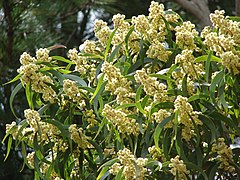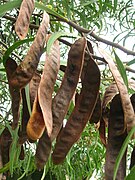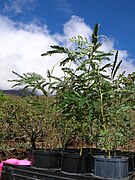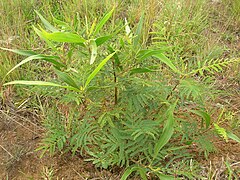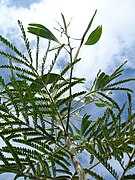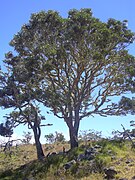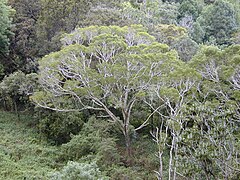Acacia koa
| Acacia koa | |
|---|---|
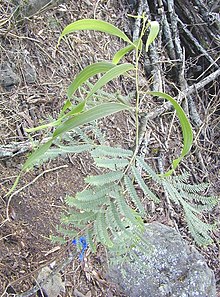
| |
| A young koa tree showing compound leaves and phyllodes | |
| Scientific classification | |
| Kingdom: | Plantae |
| Clade: | Tracheophytes |
| Clade: | Angiosperms |
| Clade: | Eudicots |
| Clade: | Rosids |
| Order: | Fabales |
| Family: | Fabaceae |
| Subfamily: | Caesalpinioideae |
| Clade: | Mimosoid clade |
| Genus: | Acacia |
| Species: | A. koa
|
| Binomial name | |
| Acacia koa | |
| Synonyms[2] | |
|
Acacia heterophyllavar.latifoliaBenth. | |
Acacia koa,commonly known askoa,[3]is a species offloweringtreein thefamilyFabaceae.It isendemicto theHawaiian Islands,[2]where it is the second most common tree.[4]The highest populations are onHawaiʻi,MauiandOʻahu.
Name[edit]
The namekoain theHawaiian languageultimately comes fromProto-Austronesian*teRasmeaning "core" or "ironwood";many names referring to certain ironwood or heartwood species in Southeast Asia and Oceania such asVitex parviflora(tugásinCebuano),Eusideroxylon zwageri(togasinTombonuwo), andIntsia bijuga(dortinPalauan) descend from this root.[5]
Koaalso means brave, bold, fearless, or warrior.[3]
Description[edit]

Koa is a largetree,typically attaining a height of 15–25 m (49–82 ft) and a spread of 6–12 m (20–39 ft).[6]In deepvolcanic ash,a koa tree can reach a height of 30 m (98 ft), a circumference of 6 m (20 ft), and a spread of 38 m (125 ft).[7]It is one of the fastest-growing Hawaiian trees, capable of reaching 6–9 m (20–30 ft) in five years on a good site.[8]
Leaves[edit]
Initially,bipinnately compound leaveswith 12–24 pairs ofleafletsgrow on the koa plant, much like other members of thepea family.At about 6–9 months of age, however, thick sickle-shaped "leaves" that are not compound begin to grow. These arephyllodes,blades that develop as an expansion of the leafpetiole.The vertically flattened orientation of the phyllodes allows sunlight to pass to lower levels of the tree. True leaves are entirely replaced by 7–25 cm (2.8–9.8 in) long, 0.5–2.5 cm (0.20–0.98 in) wide phyllodes on an adult tree.[6]
Flowers[edit]
Flowersof the koa tree are pale-yellowsphericalracemeswith a diameter of 8–10 mm (0.31–0.39 in).[9]Flowering may be seasonal or year round depending on the location.[6]
Fruit[edit]
Fruitproduction start occurring when a koa tree is between 5 and 30 years old. The fruit arelegumes,also called pods, with a length of 7.5–15 cm (3.0–5.9 in) and a width of 1.5–2.5 cm (0.59–0.98 in). Each pod contains an average of 12seeds.The 6–12 mm (0.24–0.47 in) long, 4–7 mm (0.16–0.28 in) wide seeds are flattenedellipsoidsand range from dark brown to black in color. The pods are mature and ready for propagation after turning from green to brown or black. Seeds are covered with a hardseed coat,and this allows them to remaindormantfor up to 25 years.Scarificationis needed beforeA. koaseeds willgerminate.[9]
Habitat[edit]
Koa isendemicto theislandsofHawaiʻi,Molokaʻi,Maui,Lānaʻi,Oʻahu,andKauaʻi,where it grows at elevations of 100–2,300 m (330–7,550 ft). It requires 850–5,000 mm (33–197 in) of annual rainfall.Acidicto neutralsoils(pHof 4–7.4)[6]that are either anInceptisolderived fromvolcanic ashor a well-drainedhistosolare preferred.[10]Its ability tofix nitrogenallows it to grow in very young volcanic soils.[4]Koa and ʻōhiʻa lehua (Metrosideros polymorpha) dominate thecanopyof Hawaiianmixed mesic forests.[11]It is also common inwet forests.[12]
Uses[edit]

The koa's trunk was used byancientHawaiiansto buildwaʻa(dugoutoutrigger canoes)[13]andpapa heʻe nalu(surfboards). Onlypaipo(bodyboards),kikoʻo,andalaiasurfboards were made from koa, however;olo,the longest surfboards, were made from the lighter and morebuoyantwiliwili(Erythrina sandwicensis).[14]The reddish wood is very similar in strength and weight to that of Black Walnut (Juglans nigra), with a specific gravity of 0.55,[9]and is now sought for use inwood carvingandfurniture.[6]Koa is also atonewood,[15]often used in the construction ofukuleles,[16]acoustic guitars,[17]andWeissenborn-style Hawaiiansteel guitars.[18]
B.C. Richused koa on some of theirelectric guitarsas well,[19]and still uses a koa-veneeredtopwoodon certain models.[20]Fender made limited edition koa wood models of theTelecasterand theStratocasterin 2006.Trey Anastasio,guitarist for the bandPhish,primarily uses a koa hollowbodyLanguedocguitar. Commercialsilvicultureof koa takes 20 to 25 years before a tree is of useful size.[21]
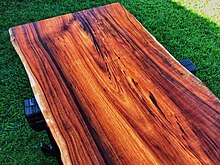
Taylor, Collings and Martin are few among the many other brands that use that tonewood for manufacturing acoustic guitars.[22]
Relation to other species[edit]
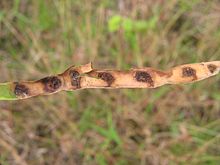
Among otherPacific Islandsofvolcanic(non-continental) origin, onlyVanuatuhas nativeAcaciaspecies.A. heterophylla,from distantRéunion,is very similar and has been suggested to be the closest relative of koa.[23]Genetic sequence analysis results announced in 2014 confirmed this close relationship; the estimated time of divergence is about 1.4 million years ago.[24][25]A. heterophyllasequences nest within those of the more diverseA. koa,making the latterparaphyletic.[25]Both species are thought to be descended from an ancestral species in Australia, presumably theirsister species,Acacia melanoxylon.Dispersals most likely occurred via seed-carrying by birds such aspetrels.[25]Both species have very similarecological niches,which differ from that ofA. melanoxylon.[25]
A closely related species, koaiʻa or koaiʻe (A. koaia), is found in dry areas. It is most easily distinguished by having smaller seeds that are arranged end-to-end in the pod, rather than side by side. Thephyllodesare also usually straighter, though this character is variable in both species. The wood is denser, harder, and more finelygrainedthan koa wood.[6]Koaiʻa has been much more heavily impacted bycattleand is now rare, but can be seen onranchland inNorth Kohala.[citation needed]
Conservation[edit]
The koa population has suffered from grazing andlogging.Manywet forestareas, where the largest koa grow, have been logged out, and it now comes largely from dead or dying trees or farms on private lands. Although formerly used foroutrigger canoes,there are few koa remaining which are both large and straight enough to do so today.[6]In areas wherecattleare present, koa regeneration is almost completely suppressed. However, if the cattle are removed, koa are among the few native Hawaiian plants able togerminatein grassland, and can be instrumental in restoring nativeforest.It is often possible to beginreforestationin apastureby diskharrowingthe soil, as thisscarifiesseeds in the soil and encourages large numbers of koa to germinate.[10]Experiments at theHakalau Forest National Wildlife Refugehave shown that ʻōhiʻa lehua (Metrosideros polymorpha) survives best in pasture when planted under koa. This is because koa trees reduceradiative cooling,preventingfrostdamage to ʻōhiʻa lehua seedlings.[26]
Ecology[edit]
Koa is the preferredhostplant for thecaterpillarsof the green Hawaiian blue (Udara blackburni), which eat the flowers and fruits.[27]Adults drinknectarfrom the flowers. Koasapis eaten by the adult Kamehameha butterfly (Vanessa tameamea).[28]The koa bug (Coleotichus blackburniae) uses its rostrum to suck the contents out of koa seeds.[29]Koa is vulnerable to infection bykoa wilt.
Gallery[edit]
This sectioncontains an unencyclopedic or excessive gallery of images. |
-
Acacia koawithphyllodebetween the branch and thecompound leaves
References[edit]
- ^Contu, S. 2012.Acacia koa.The IUCN Red List of Threatened Species 2012: e.T19891713A19999145.https://dx.doi.org/10.2305/IUCN.UK.2012.RLTS.T19891713A19999145.en.Downloaded 8 May 2017.
- ^ab"Acacia koa".Germplasm Resources Information Network.Agricultural Research Service,United States Department of Agriculture.Retrieved2010-05-03.
- ^abKepler, Angela Kay (1998).Hawaiian Heritage Plants.University of Hawaii Press. p. 106.ISBN978-0-8248-1994-1.
- ^abIdol, Travis (2008-04-16)."Environmental Controls Over Acacia koa Productivity".Travis Idol's Research Page.University of Hawaiʻi at Mānoa.Retrieved2009-01-31.
- ^Blust, Robert;Trussel, Stephen (2010)."*teRas:heartwood of a tree, hard, durable core of wood; ironwood tree ".Austronesian Comparative Dictionary.Max Planck Institute for Evolutionary Anthropology.Retrieved27 December2022.
- ^abcdefgElevitch, Craig R.; Kim M. Wilkinson; J. B. Friday; C. Baron Porter (April 2006)."Acacia koa (koa) and Acacia koaia (koaiʻa)"(PDF).The Traditional Tree Initiative.
{{cite journal}}:Cite journal requires|journal=(help) - ^Welsbacher, Anne (2003).Life in a Rain Forest.Twenty-First Century Books. p. 30.ISBN978-0-8225-4685-6.
- ^Wilkinson, Kim M.; Craig R. Elevitch (2003).Growing Koa: A Hawaiian Legacy Tree.Hōlualoa, Hawai'i:Permanent Agriculture Resources. p. 13.ISBN978-0-9702544-2-9.
- ^abcAllen, James A. (2003-01-01)."Acacia koa A. Gray"(PDF).Tropical Tree Seed Manual.Reforestation, Nurseries & Genetics Resources.Retrieved2009-02-23.
- ^abWhitesell, Craig D (1990)."Acacia koa".In Burns, Russell M.; Honkala, Barbara H. (eds.).Hardwoods.Silvics of North America.Vol. 2.Washington, D.C.:United States Forest Service(USFS),United States Department of Agriculture(USDA).Archivedfrom the original on 20 January 2009.Retrieved2009-02-17– via Southern Research Station.
- ^Ziegler, Alan C. (2002).Hawaiian Natural History, Ecology, and Evolution.University of Hawaii Press. pp. 175–176.ISBN978-0-8248-2190-6.
- ^Sohmer, S. H.; R. Gustafson (1987).Plants and Flowers of Hawaiʻi.University of Hawaii Press. pp. 45–52.ISBN978-0-8248-1096-2.
- ^Bryan, William Alanson (1915).Natural History of Hawaii, Being an Account of the Hawaiian People, the Geology and Geography of the Islands, and the Native and Introduced Plants and Animals of the Group.Hawaiian Gazette Co, Ltd. p.339.ISBN978-1-4446-7820-8.
- ^Marcus, Ben; Juliana Morais; Jeff Divine; Gary Linden (2007).The Surfboard: Art, Style, Stoke.MBI Publishing Company. pp. 17–19.ISBN978-0-7603-2753-1.
- ^Beberman, Norman L."Koa: Beautiful Looking, Beautiful Sounding Tonewood".GuitarNation.com.Archivedfrom the original on 7 February 2009.Retrieved2009-02-23.
- ^Gernot Rödder (2002).Total Ukulele: D-Tuning Method for Beginners.Mel Bay Publications. p. 93.ISBN978-3-8024-0446-7.
- ^Gerken, Teja (2000).Acoustic Guitar Owner's Manual: The Complete Guide.String Letter Publishing. p. 10.ISBN978-1-890490-21-8.
- ^Sheperd, John (2003)."Guitars".Continuum Encyclopedia of Popular Music of the World.Vol. II: Performance and Production. Continuum International Publishing Group. p. 283.ISBN978-0-8264-6322-7.
- ^Achard, Ken (1989).The History and Development of the American Guitar.Bold Strummer Ltd. p. 163.ISBN978-0-933224-18-6.
- ^Kirkland, Eric (December 2006). "Rich and Famous".Guitar World:154.
- ^"Silviculture: Diversification of Rural Economy".Leeward Haleakalā Watershed Restoration Partnership.Retrieved2009-02-01.
- ^"Is Koa Wood The Ultimate Choice For Guitar Enthusiasts?".Best Guitars Now.Retrieved2023-11-24.
- ^Whitesell, Craig D (1964)."Silvical Characteristics of Koa (Acacia koaGray) "(PDF).United States Forestry Service.
{{cite journal}}:Cite journal requires|journal=(help) - ^Marris, E. (2014-06-19)."Tree hitched a ride to island".Nature.510(7505): 320–321.Bibcode:2014Natur.510..320M.doi:10.1038/510320a.PMID24943937.
- ^abcdLe Roux, J. J.; Strasberg, D.; Rouget, M.; Morden, C. W.; Koordom, M.; Richardson, D. M. (2014-06-18)."Relatedness defies biogeography: The tale of two island endemics (Acacia heterophyllaandA. Koa)".New Phytologist.204(1): 230–242.doi:10.1111/nph.12900.PMID24942529.
- ^Friday, J. B.; Darrell A. Herbert (April 2006)."Metrosideros polymorpha ('ōhi'a lehua)"(PDF).The Traditional Tree Initiative: 21.
{{cite journal}}:Cite journal requires|journal=(help) - ^Scott, James A. (1992).The Butterflies of North America: A Natural History and Field Guide.Stanford University Press. p. 399.ISBN978-0-8047-2013-7.
- ^Scott, Susan (1991).Plants and Animals of Hawaii.Bess Press. p.78.ISBN978-0-935848-93-9.
- ^"Koa Bug Investigation"(PDF).Uhh.hawaii.edu.Retrieved15 March2022.
External links[edit]
 Media related toAcacia koaat Wikimedia Commons
Media related toAcacia koaat Wikimedia Commons Data related toAcacia koaat Wikispecies
Data related toAcacia koaat Wikispecies- Photos of Acacia koaat Hawaiian Ecosystems at Risk Project (HEAR)
- UCLA botanical garden and home
- Historic photos and descriptions ofAcacia koa


